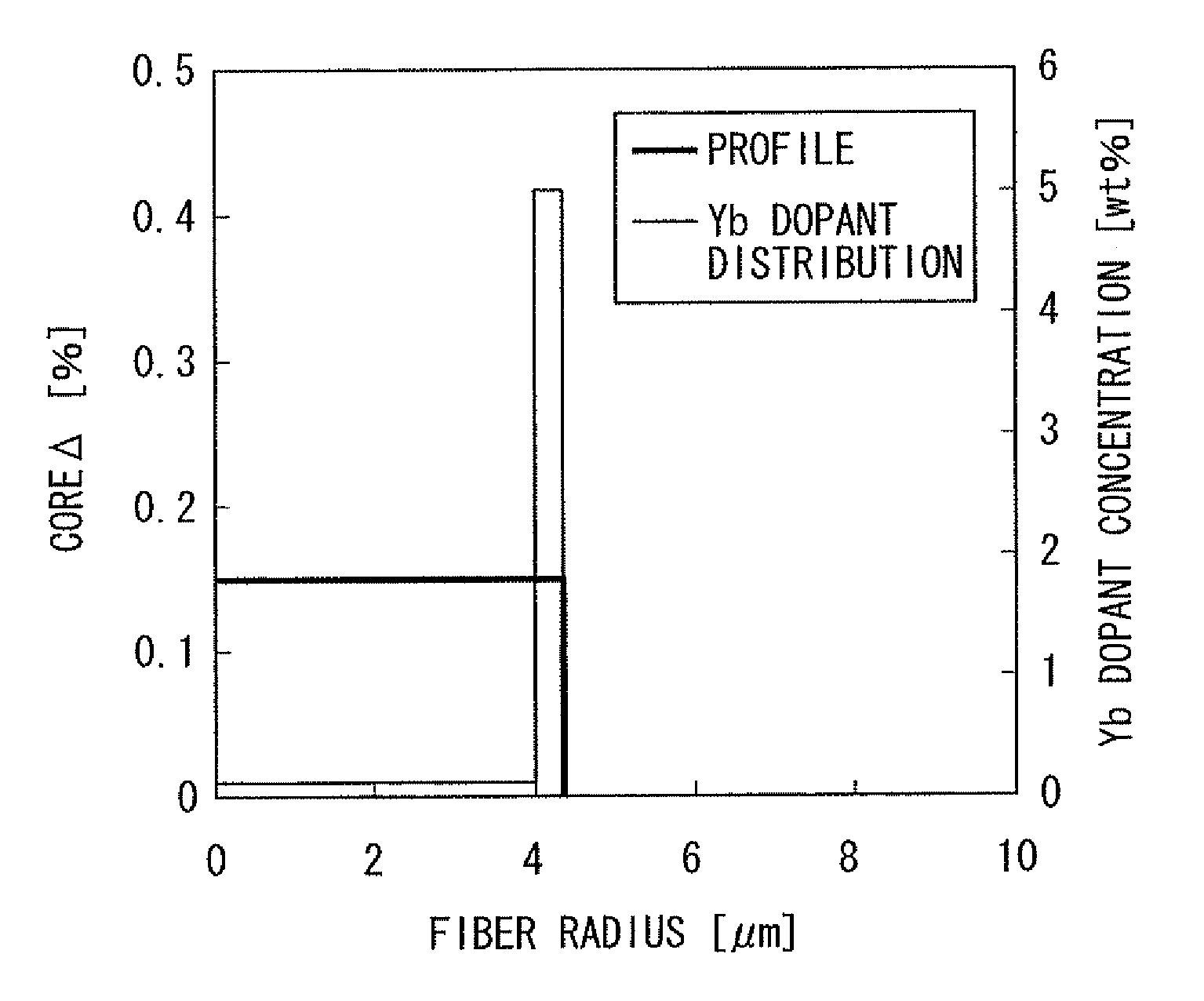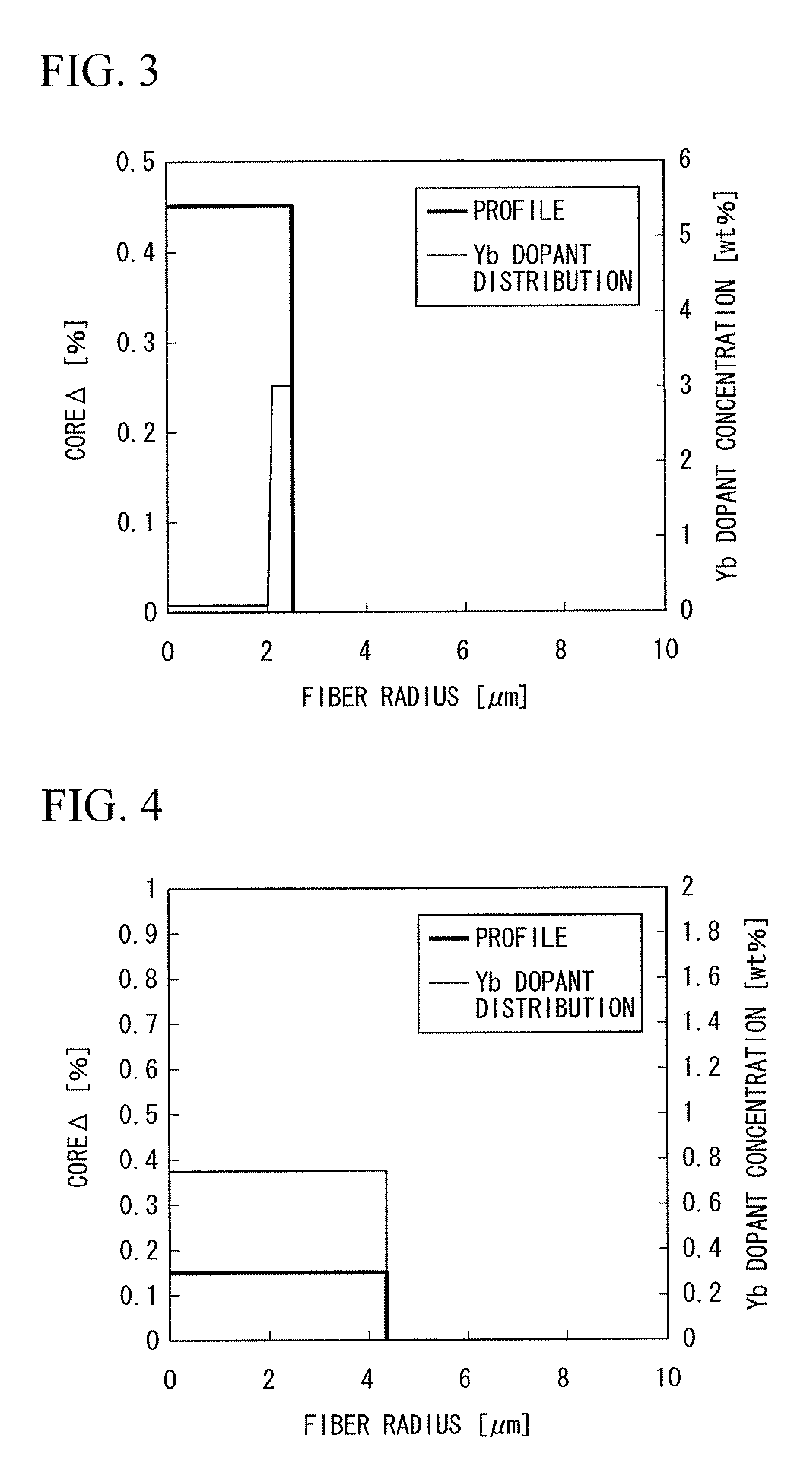Rare-earth doped optical fiber, method of producing the same, and fiber laser
a technology of optical fiber and rare earth, applied in the field of rare earth doped optical fiber, can solve the problems of difficult to maintain manufacturing stability, increase the loss of optical fiber, and reduce the loss of oscillation light, so as to improve the oscillation efficiency, reduce the loss of optical fiber, and increase the optical loss of optical fiber.
- Summary
- Abstract
- Description
- Claims
- Application Information
AI Technical Summary
Benefits of technology
Problems solved by technology
Method used
Image
Examples
example 1
[0070]An optical fiber core preform according to the design shown in FIG. 1 is obtained in the following manner. A glass soot is formed by depositing in a modified chemical vapor deposition (MCVD) process, and then aluminum (Al) and ytterbium (Yb) are doped to the glass soot in a solution doping process according to the design shown in FIG. 1. The doped glass soot is subject to sintering and collapse processes to prepare a core preform. Then a clad is formed on a surface of the core preform in a jacketing process. In this manner, an optical fiber preform (having a core Δ of 0.15% and a core radius of 4.4 μm) that has the refractive index profile and the Yb dopant distribution shown in FIG. 1 is obtained.
[0071]The preform is then drawn in a drawing device. Low-refractive-index polymer resin is deposited to cover the optical fiber preform to provide a rare-earth doped double-clad fiber.
[0072]The core Δ (i.e., the difference in relative refractive index between the core and the first c...
example 2
[0075]An optical fiber core preform according to the design shown in FIG. 2 is obtained in the following manner. A glass soot is formed by depositing in a VAD process, and then aluminum (Al) and ytterbium (Yb) are doped to the glass soot in a solution doping process according to the design shown in FIG. 2. The obtained glass soot is subject to a sintering process to prepare a core preform. Then a clad is formed on a surface of the core preform in an outside vapor deposition process. In this manner, an optical fiber preform (having a core Δ of 0.10% and a core radius of 5.4 μm) that has the refractive index profile and the Yb dopant distribution shown in FIG. 2 is obtained.
[0076]The preform is then drawn in a drawing device. Low-refractive-index polymer resin is deposited to cover the optical fiber preform to provide a rare-earth doped double-clad fiber.
[0077]The core Δ is provided by aluminum (Al) and germanium (Ge) doped to the core.
[0078]A value calculated by Equation (2) is 0.27 ...
example 3
[0080]An optical fiber core preform according to the design shown in FIG. 3 is obtained in the following manner. A glass soot is formed by depositing in a plasma chemical vapor deposition (PCVD) process, and then aluminum (Al) and ytterbium (Yb) are doped to the glass soot in a solution doping process according to the design shown in FIG. 3. The obtained glass soot is subject to a sintering process to prepare a core preform. A clad is formed on a surface of the core preform in an outside vapor deposition process. In this manner, an optical fiber preform (having a core Δ of 0.45% and a core radius of 2.5 μm) that has the refractive index profile and the Yb dopant distribution shown in FIG. 3 is obtained.
[0081]The preform is then drawn in a drawing device. Low-refractive-index polymer resin is deposited to cover the optical fiber preform to provide a rare-earth doped double-clad fiber.
[0082]The core Δ is provided by aluminum (Al), germanium (Ge), and fluoride (F) doped to the core.
[00...
PUM
 Login to View More
Login to View More Abstract
Description
Claims
Application Information
 Login to View More
Login to View More - R&D
- Intellectual Property
- Life Sciences
- Materials
- Tech Scout
- Unparalleled Data Quality
- Higher Quality Content
- 60% Fewer Hallucinations
Browse by: Latest US Patents, China's latest patents, Technical Efficacy Thesaurus, Application Domain, Technology Topic, Popular Technical Reports.
© 2025 PatSnap. All rights reserved.Legal|Privacy policy|Modern Slavery Act Transparency Statement|Sitemap|About US| Contact US: help@patsnap.com



